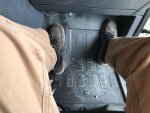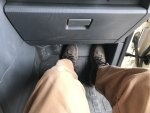I went to the driving event at the Ram Off-Road Park in Colorado Springs on Friday April 21, 2023. I got there early, and they let me drive the course before my appointment, and I was the only car on the course (which was pretty cool), and then they let me drive it a second time during my scheduled appointment. These were my impressions:
The staff was great: professional, knowledgeable, and friendly.
The course was good - but not great. There was a 35-37 degree side-slope, a couple of short steep hills to both climb and descend, some tight turns, but nothing very technical. It was a more challenging course than most manufacturers would turn you loose on, but if you regularly drive off-road in Colorado, this was about a 4 on the OnX Off Road scale from 0-10.
Here are my impressions. These may - or may not - be relevant to you. You may - or may not - use your off-road vehicle the same way that I do.
Positive impressions:
1. The Grenadier handled it all very well, and felt very planted - especially on the side slope.
2. The suspension is fantastic. Wheel travel is good, it articulates well, and the springs and shocks work well together to mitigate rough terrain. The Grenadier is comfortable and quiet off-road.
3. The steering felt precise off-road. We were in 4-low the whole time, and never got up to speed, so I cannot speak to on-road driving characteristics.
4. In low-range, the B58 (gas engine) has excellent low-end torque; it would have been good to see how it felt in high-range, but that was not allowed. The engine and transmission worked well together in low-range, and the throttle was easy to modulate. While max horsepower and torque are no where near class leading (282 hp, 332 lb/ft. torque), and are not great for a vehicle of this weight (around 5,800 pounds), forced induction will provide better driving dynamics than a naturally aspirated engine with similar max-power numbers. Forced induction will also help the Grenadier at altitude.
5. The Grenadier is solid. (a) The frame resembles that of a heavy duty pickup (e.g. Ford F250, Ram 2500); (b) The running gear (tie rod, drag link, track bar) resemble what you would see on a solid front axle Landcruiser - much beefier than a Jeep Wrangler, but not quite as stout as a heavy duty truck; (c) the axles are beefier than a Jeep Wrangler, but less stout than a heavy duty truck.
6. All moving parts in the body are aluminum (hood, four side doors, two rear doors). All the doors feel well-made, and close with a satisfying feel, that speaks to how well-sealed they are against the elements.
7. The seats are super-comfortable (obviously, that assessment is highly subjective).
Not-so positive impressions:
1. We were not allowed to engage the front and rear differential locks, nor were we allowed to shift out of 4-low.
2. Given its clear intention to be a rugged 4x4, the Grenadier has good - but not great - ground clearance. Top off-road models from Jeep and Ford can be equipped from the factory with 35-inch tires (with corrected gearing, no rubbing, a full-size spare tire, and a factory warranty). I understand that the vision for the Grenadier is rugged overlander, not rock crawler, but many of us will want to use it for a bit of both. Most drivers were hitting the rear differential on a rock that wasn't very big. The Ineos guides requested that people either take it very slow, or place a tire on the rock (as opposed to straddling it). Placing tires on top of rocks is basic off-roading, but on harder trails, you need better ground clearance. I am not a hard-core rock crawler, but we regularly travel through terrain with much larger rocks than on this test course. If the Grenadier were more easily modified, this would not be a concern. However, the Grenadier will not take well to larger tires for the following reasons: (a) short control arms, (b) lack of re-gearing options for the Carraro axles, and (c) a split rear door that will not accommodate a tire larger than 33-inches in diameter. Some - or all - of this
may get addressed in the aftermarket.
3. Engine braking going down steep hills is good, but not great. For my style of off-road driving, I would prefer a lower, low range. The Grenadier has a low range of 2.5:1, whereas as a Wrangler Rubicon has a low-range of 4:1. The Rubicon transfer case is better-suited to technical off-road driving in Colorado. The Grenadier transfer case will be better for sand, and higher speed off-roading while still needing low-range.
4. For an off-road vehicle - the gear selector is awful. The haptics do not provide the simple and tactile feedback required in a true off-road vehicle. A gear selector in a 4x4 needs to (a) move, so that shifting is positive, and can be verified by both feel and sight, (b) positively engage with gears, and (c) not be prone to shifting out of gear with a moderate tap or bump - which can happen while off-roading. The BMW gear selector fails on every count. To put it into park, you press a button on the gear selector; nothing moves, and there is no confirmation of being in park, other than a little light on the dash. To put it in drive, you press a button and pull back; the selector pivots backward, then returns to its regular position. There is no visible sign of what gear you are in, other than a little light on the dash. To go into "manual mode" you tap it to the left - but again, it pivots, but does not move over to the left - so there is no good feedback. In manual mode, you can up-shift by tapping rearwards, or down-shift by tapping forwards. If your tap to the left did not actually put the vehicle in manual mode, then - if you forward tap (thinking you are downshifting) - you will put the truck into neutral, and you will suddenly lose all engine braking. The gear selector completely fails to match other components in the Grenadier - which are rugged, and positive in their engagement. It is also a bit bizarre that this electronic gear selector is sandwiched between a manual handbrake, and a manual lever for the transfer case. The Jeep Wrangler and Gladiator use the same ZF transmissions as the Grenadier, but have a far superior gear selector. It moves and then positively engages whatever gear you select, and moves when you shift to manual mode. Everyone is entitled to their opinion - this is mine.
5. Tim (the Ineos representative from England, who was in charge of discussing the undercarriage), said that the axles were semi-float, not full-float (see:
Full-Floating vs Semi-Floating Axles). For 2024, Jeep is offering full-float axles as an option in the Wrangler, and all heavy-duty trucks have full-float axles, so this was a disappointment, and a bit of a surprise given the high payload for the Grenadier (close to 2,000 pounds).
6. This is a minor issue, but a lot of the reviews I read raved about how the HVAC controls are “big and chunky”. To me, they are not that big, and do not stick-out that much from the dash, and will not be that easily adjusted with gloves. Here is an example of HVAC controls, from a Toyota 4-Runner, that can be easily adjusted wearing winter gloves; the photo also provides an example of a gear selector that moves, and positively engages into gear:

7. The footrest intrusion on the right-hand footwell is not as bad as some online reports indicate, but it is far from ideal. If the passenger wants to place their left foot on the footrest, it is quite comfortable - for a while - but obviously not symmetrical (see first photo). However, if the passenger wants to stretch out both legs - which is necessary on long drives - they cannot sit straight. Instead, you have to pivot in the seat (to the right), but then your whole body is off-kilter in the seat (at least this was true for me, at 6' 2" tall). That was my experience - yours may differ.

You can't see from this photo, but my hips are not square in the seat:





